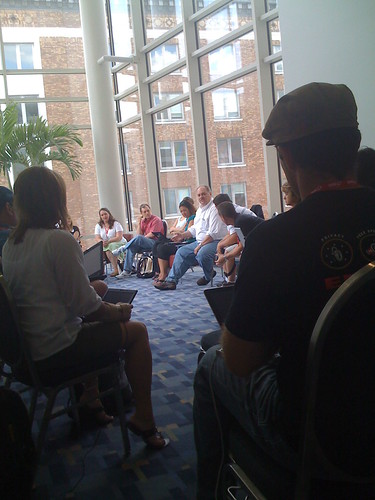 |
|
|
2009 was the year that my 4th of July lasted for 42 hours, at least that’s the best I could calculate it at the end of the day. Much of the day was in Auckland, New Zealand, then the flight to San Francisco, a four hour layover, and then five more hours across North America. A bit ragged this morning.
I’ve been been reflecting, though, about my NECC experience — especially the conversations at the Leadership Symposium and a couple of the conversations I had at the EduBloggerCon. The idea is starting to jell in my mind that the next big… Hmmmm!
As I wrote yesterday, it seems that everytime we sit down and talk about education reform, there seems to be something in the way, preventing us from what we want to do right now. We can’t move that tile in the puzzle, until the one next to it is out of the way, which we can’t move until another one has been shifted, etc. etc. There is only one open space in the old Cracker Jack puzzle game, and often only two tiles that can be shifted to make room. In our particular game of education reform, it seems to me that there is only one tile that can be moved into one empty space. But when that one is shifted, a domino affect may result, leaving room for a sudden and complete overhaul of education.
That tile is how we assess the quality of education for the sake of accountability — namely the high-stakes government issued tests. No surprise here. We’ve all had this conversation. And we are starting to feel that there is a new spirit for doing things differently.
 |
|
|
However, accountability continues to be a focused part of conversations, especially in the monologs coming from the Education Department — and I don’t think we should hold our breaths for any proclaimations of a different kind of assessment coming from Washington.
So what might spark the change. What might the catalyst be. What’s going to jolt us to a new level. I’m wondering if the next killer app, at least for education, might be a highly innovation new eportfolio platform. It will be something that we all get so excited about, that we’ll all want to use it. We’ll want our communities to be excited about it. We’ll want to switch to eportfolio assessment, because we’ll want to use this new thing.
Here are a few features that would excite me:
- It won’t be just a digital folder. The killer eportfolio app will be about much more than assessment.
- It will be used all year long, not just at assessment time at the end of the year.
- It will be a work platform, not just an archive for assessment.
- It will have elements of social networking, featuring personal profiles and a variety of communication devices, such as blogging, micro-blogging, discussion forums, and commenting.
- It will easily and invitingly accept multimedia products.
- All products will be critiqueable with commenting or threaded discussion, by educators, fellow students, and the verifiable community.
- It will also have components of a course management system. There will be curriculum structures within the platform so that work can be aligned, at least implicitly, with instructional objectives.
- There will be a facility to critique work based beyond mere foundational standards. Work will also be judged on inventiveness, collaboration, quality of communication, compellingness, value to an authentic audience.
- “Standards” will play a minimal roll in this product.
- It will facility portability, so that students can carry their portfolios with them to the next grade and/or as a standalone product on CD or other networked platform.
- It will not merely be classroom-friendly. It will be user-friendly, regardless of the location of the learning.
- Students will want to spend time here. They will have a strong voice and hand in what it looks like and how it operates.
- Students will be able to enter products that are not necessarily curriculum related, such as personal video and machinima creations, art work, game scores, business ventures, and products of personal and passionate interest.
- The work will belong to the students.
- Students, teachers, and parents will participate in selecting the work that is assessed.
- Assessment will be school-based, government-based, and community-based.
- It will preferably be open source, but not necessarily so.
- The social aspects will be reasonably open. Students (and teachers) will be able to collaborate across classroom and school (and even national) boundaries.
- Assessment will be based on content, quality & compellingness of the communication, and value.
- All learning products will include an element of reflection by its producer.
- It will become the talk of the town.
Please suggest your own features. I would love to see this happen before the next NECC.

